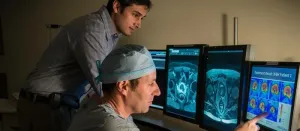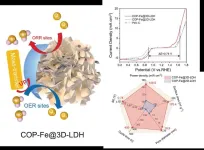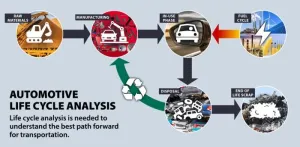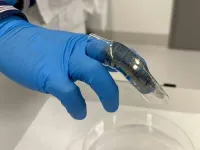(Press-News.org) Particle accelerators are crucial tools in a wide variety of areas in industry, research and the medical sector. The space these machines require ranges from a few square meters to large research centers. Using lasers to accelerate electrons within a photonic nanostructure constitutes a microscopic alternative with the potential of generating significantly lower costs and making devices considerably less bulky. Until now, no substantial energy gains were demonstrated. In other words, it has not been shown that electrons really have increased in speed significantly. A team of laser physicists at Friedrich-Alexander-Universität Erlangen-Nürnberg (FAU) has now succeeded in demonstrating the first nanophotonic electron accelerator – at the same time as colleagues from Stanford University. The researchers from FAU have now published their findings in the journal Nature.*
When people hear “particle accelerator”, most will probably think of the Large Hadron Collider in Geneva, the approximately 27 kilometer long ring-shaped tunnel which researchers from around the globe used to conduct research into unknown elementary particles. Such huge particle accelerators are the exception, however. We are more likely to encounter them in other places in our day to day lives, for example in medical imaging procedures or during radiation to treat tumors. Even then, however, the devices are several meters in size and still rather bulky, with room for improvement in terms of performance. In a bid to improve and decrease the size of existing devices, physicists around the globe are working on dielectric laser acceleration, also known as nanophotonic accelerators. The structures they use are merely 0.5 millimeters in length, and the channel the electrons are accelerated through is only roughly 225 nanometers in width, making these accelerators as small as a computer chip.
Particles are accelerated by ultrashort laser pulses illuminating the nano-structures. “The dream application would be to place a particle accelerator on an endoscope in order to be able to administer radiotherapy directly at the affected area within the body,” explains Dr. Tomáš Chlouba, one of the four lead authors of the recently published paper. This dream may still be far beyond the grasp of the FAU team from the Chair of Laser Physics led by Prof. Dr. Peter Hommelhoff and consisting of Dr. Tomáš Chlouba, Dr. Roy Shiloh, Stefanie Kraus, Leon Brückner and Julian Litzel, but they have now succeeded in taking a decisive step in the right direction by demonstrating the nanophotonic electron accelerator. “For the first time, we really can speak about a particle accelerator on a chip,” enthuses Dr. Roy Shiloh.
Guiding electrons + acceleration = particle accelerator
Just over two years ago the team made their first major breakthrough: they succeeded in using the alternating phase focusing (APF) method from the early days of acceleration theory to control the flow of electrons in a vacuum channel over long distances (see press release of September 23, 2021: https://www.fau.eu/2021/09/23/news/research/fau-physicists-control-the-flow-of-electron-pulses-through-a-nanostructure-channel/). This was the first major step on the way towards building a particle accelerator. Now, all that was needed to gain major amounts of energy was acceleration. “Using this technique, we have now succeeded not only in guiding electrons but also in accelerating them in these nano-fabricated structures over a length of half a millimeter,” explains Stefanie Kraus. Whilst this might not sound like much of an achievement to many, it is a huge success for the field of accelerator physics. “We gained energy of 12 kiloelectron volts. That is a 43 percent gain in energy,” explains Leon Brückner.
In order to accelerate the particles over such large distances (when seen from the nano scale), the FAU physicists combined the APF method with specially developed pillar-shaped geometrical structures.
This demonstration is just the beginning, however. Now the aim is to increase the gain in energy and electron current to such an extent that the particle accelerator on a chip is sufficient for applications in medicine. For this to be the case, the gain in energy would have to be increased by a factor of approximately 100. “In order to achieve higher electron currents at higher energies at the output of the structure, we will have to expand the structures or place several channels next to each other,” Tomáš Chlouba explains the next steps of the FAU laser physicists.
Head-to-head race among physicists
What the Erlangen laser physicists succeeded in doing was demonstrated almost simultaneously by colleagues at Stanford University in the United States: Their results are currently under review, but can be viewed on a repository. The two teams are working together on the realization of the "Accelerator on a chip" in a project funded by the Gordon and Betty Moore Foundation (https://www.fau.eu/2015/11/19/news/research/a-mini-particle-accelerator/). “In 2015, the FAU and Stanford led ACHIP team had a vision for a revolutionary approach to particle accelerator design”, said Dr. Gary Greenburg of the Gordon and Betty Moore Foundation, "and we are delighted that our support has helped turn this vision into reality."
* Original FAU publication: T. Chlouba, R. Shiloh, S. Kraus, L. Brückner, J. Litzel and P. Hommelhoff, https://www.nature.com/articles/s41586-023-06602-7
Original Stanford publication: P. Broaddus, T. Egenolf, D. S. Black, M. Murillo, C. Woodahl, Yu Miao, U. Niedermayer, R. L. Byer, K. J. Leedle, O. Solgaard, arXiv:2310.02434
END
Milestone: Miniature particle accelerator works
FAU team of researchers succeed for the first time in accelerating electrons using a nano device
2023-10-18
ELSE PRESS RELEASES FROM THIS DATE:
Simple MRI scan could predict radiation side effects for prostate cancer
2023-10-18
A new Corewell Health study suggests that men who have longer prostatic urethras, the part of the urethra that travels through the prostate, may be at a higher risk of experiencing moderate, often chronic urinary side effects after receiving radiation for prostate cancer.
To date, researchers have struggled to determine any risk factors that could shed light on who might experience these types of side effects ahead of time. But now, a simple MRI scan and a new metric to determine urethra length could change that.
Results, now published in the journal Academic Radiology, indicate that for every 1-centimeter increase in length of the prostatic ...
A newly hierarchically porous pyrolysis-free bifunctional catalyst to boost ultralong lifespan zinc-air batteries
2023-10-18
They published their work on Oct. 12 in Energy Material Advances.
"The development of cost-effective and high-performance zinc-air battery cathode catalyst is imperative," said paper author Zhonghua Xiang, professor with the Beijing University of Chemical Technology. "Currently, zinc-air batteries still not occupy the market, because they are limited in both stability and in their energy density."
Xiang explained that zinc-air batteries can only work for very limited time at high current density, because there are lots of problems of its cathode, anode and electrolyte.
"The air ...
Do adult periodical cicadas actually feed on anything?
2023-10-18
Annapolis, MD; October 18, 2023—Every so often, cicadas emerge above ground and blanket the earth with their exoskeletons while emitting a high-pitched chirp from sunrise to sunset. The periodical cicadas in the genus Magicicada come every 13 or 17 years, though other types of cicadas emerge much more frequently in our neighborhoods. A long-standing agricultural query related to the periodical cicadas was recently answered by an Agricultural Research Service (USDA-ARS) research team at West Virginia's Appalachian Fruit Research Station. Simply: Once periodical ...
SwRI to host Life-Cycle Analysis for Transportation Symposium Nov. 16-17
2023-10-18
SAN ANTONIO — October 18, 2023 —Southwest Research Institute will host the Life-Cycle Analysis for Transportation Symposium on Nov. 16-17 in San Antonio. This year’s symposium will be in person for the first time.
The two-day event will highlight academic, industry and institutional research efforts to characterize the total greenhouse gas emissions produced during the entire life cycle of a vehicle, including its manufacture, service life and recycling or disposal.
“We often talk about getting to ‘zero-emissions,’ but this definition often ...
ASHG 2023 Annual Meeting to welcome thousands of researchers in Washington, DC to advance human genetics and genomics discoveries and applications
2023-10-18
Media Contact: Kara Flynn, 202.257.8424, press@ashg.org
For Immediate Release: Wednesday, October 18, 2023, 10:00am U.S. Eastern Time
ROCKVILLE, MD — More than ever before, human genetics and genomics is an essential part of making progress in research, biotechnology, and health. As a key leader supporting research innovation, the American Society of Human Genetics (ASHG) will convene more than 8,000 researchers and clinicians at the ASHG 2023 Annual Meeting in Washington DC, Nov. 1-5 to share emerging discoveries and celebrate the Society’s 75th anniversary.
“Human genetics is transforming science and health at a rapid ...
Map: Wildlife polluted by flame retardants on massive scale
2023-10-18
More than 150 species of wild animals across every continent are contaminated with flame retardant chemicals, according to a new map tracking peer-reviewed research worldwide. Polluted wildlife include killer whales, red pandas, chimpanzees and other endangered species. Added to furniture, electronics, vehicles, and other everyday products to meet flammability standards, the chemicals often do not work as intended. They also migrate out of products and into wildlife—and people.
“Flame retardants don’t actually make TV enclosures and car interiors more fire-safe, but they can harm people and animals,” ...
New insights into the genetics of the common octopus: genome at the chromosome level decoded
2023-10-18
Octopuses are fascinating animals – and serve as important model organisms in neuroscience, cognition research and developmental biology. To gain a deeper understanding of their biology and evolutionary history, validated data on the composition of their genome is needed, which has been lacking until now. Scientists from the University of Vienna together with an international research team have now been able to close this gap and, in a study, determined impressive figures: 2.8 billion base pairs - organized in ...
Researchers unveil fire-inhibiting nonflammable gel polymer electrolyte for lithium-ion batteries
2023-10-18
A collaborative research team, led by Professor Hyun-Kon Song in the School of Energy and Chemical Engineering at UNIST, Dr. Seo-Hyun Jung from Research Center for Advanced Specialty Chemicals at Korea Research Institute of Chemical Technology (KRICT), and Dr. Tae-Hee Kim from the Ulsan Advanced Energy Technology R&D Center at Korea Institute of Energy Research (KIER), has achieved a groundbreaking milestone in battery technology. Their remarkable achievement in developing a non-flammable gel polymer electrolyte (GPE) is set to revolutionize the safety of lithium-ion batteries (LIBs) by ...
Test of police implicit bias training shows modest improvements
2023-10-18
SPOKANE, Wash. – A two-part training designed to help police officers recognize their implicit bias, revealed some behavior improvement and lowered citizen discrimination complaints in a controlled study. While a small study involving one police department, it is the first-known research to provide evidence that this type of training can produce positive behavioral effects.
Led by Washington State University researcher Lois James, the study found some improvement in the anti-bias trained officers’ behavior toward homeless people in particular, ...
Wearable device makes memories and powers up with the flex of a finger
2023-10-18
Researchers have invented an experimental wearable device that generates power from a user’s bending finger and can create and store memories, in a promising step towards health monitoring and other technologies.
The innovation features a single nanomaterial incorporated into a stretchable casing fitted to a person’s finger. The nanomaterial enabled the device to generate power with the user bending their finger.
The super-thin material also allows the device to perform memory tasks, as outlined below.
Multifunctional devices normally require several materials in layers, which involves the time-consuming challenge of stacking nanomaterials with high precision.
The team, led ...
LAST 30 PRESS RELEASES:
Numbers in our sights affect how we perceive space
SIMJ announces global collaborative book project in commemoration of its 75th anniversary
Air pollution exposure and birth weight
Obstructive sleep apnea risk and mental health conditions among older adults
How talking slows eye movements behind the wheel
The Ceramic Society of Japan’s Oxoate Ceramics Research Association launches new international book project
Heart-brain connection: international study reveals the role of the vagus nerve in keeping the heart young
Researchers identify Rb1 as a predictive biomarker for a new therapeutic strategy in some breast cancers
Survey reveals ethical gaps slowing AI adoption in pediatric surgery
Stimulant ADHD medications work differently than thought
AI overestimates how smart people are, according to HSE economists
HSE researchers create genome-wide map of quadruplexes
Scientists boost cell "powerhouses" to burn more calories
Automatic label checking: The missing step in making reliable medical AI
Low daily alcohol intake linked to 50% heightened mouth cancer risk in India
American Meteorological Society announces Rick Spinrad as 2026 President-Elect
Biomass-based carbon capture spotlighted in newly released global climate webinar recording
Illuminating invisible nano pollutants: advanced bioimaging tracks the full journey of emerging nanoscale contaminants in living systems
How does age affect recovery from spinal cord injury?
Novel AI tool offers prognosis for patients with head and neck cancer
Fathers’ microplastic exposure tied to their children’s metabolic problems
Research validates laboratory model for studying high-grade serous ovarian cancer
SIR 2026 delivers transformative breakthroughs in minimally invasive medicine to improve patient care
Stem Cell Reports most downloaded papers of 2025 highlight the breadth and impact of stem cell research
Oxford-led study estimates NHS spends around 3% of its primary and secondary care budget on the health impacts of heat and cold in England
A researcher’s long quest leads to a smart composite breakthrough
Urban wild bees act as “microbial sensors” of city health.
New study finds where you live affects recovery after a hip fracture
Forecasting the impact of fully automated vehicle adoption on US road traffic injuries
Alcohol-related hospitalizations from 2016 to 2022
[Press-News.org] Milestone: Miniature particle accelerator worksFAU team of researchers succeed for the first time in accelerating electrons using a nano device







